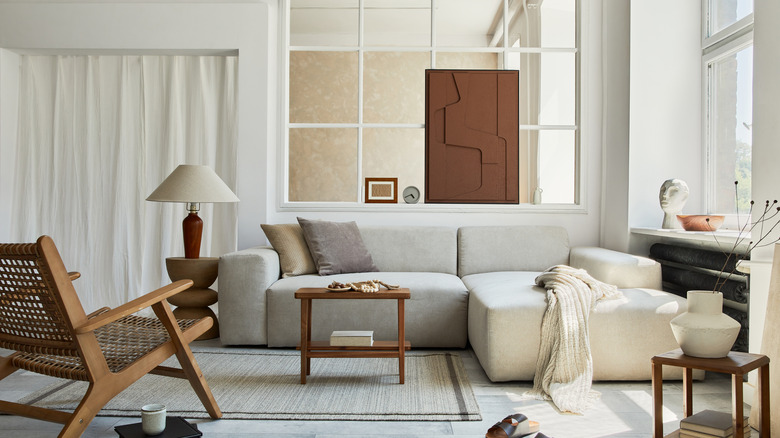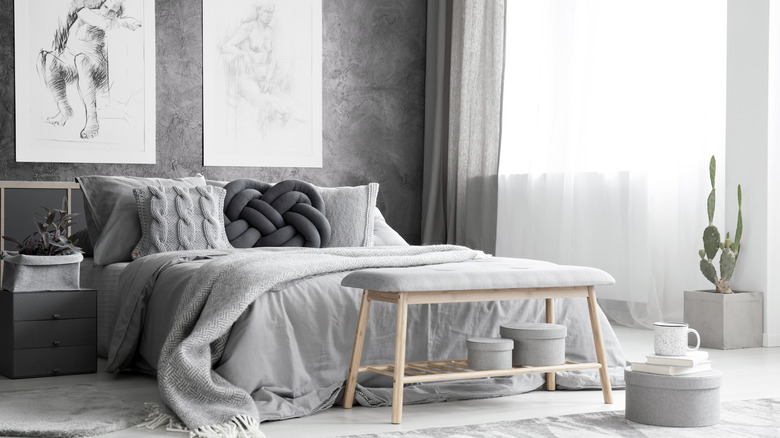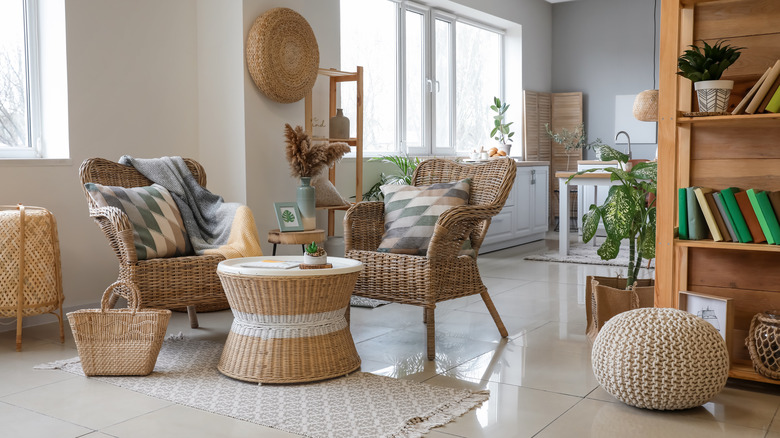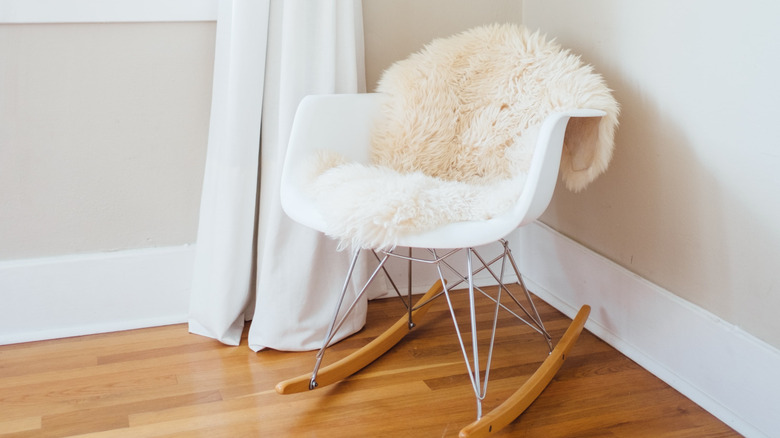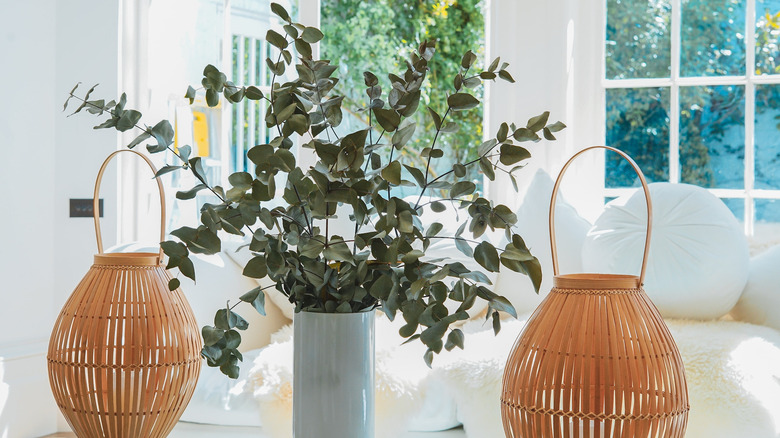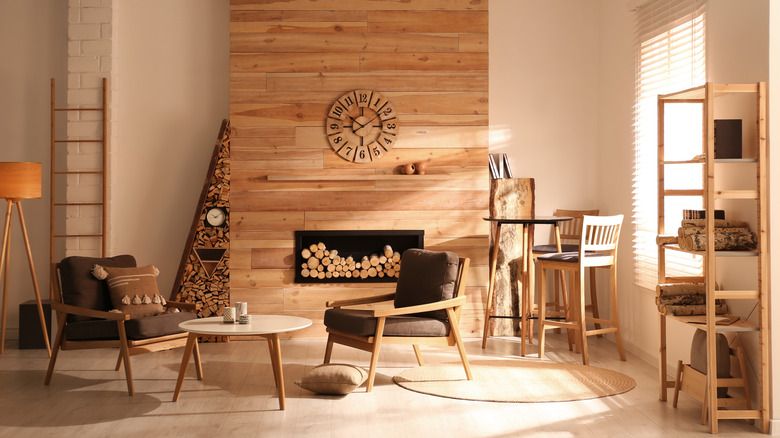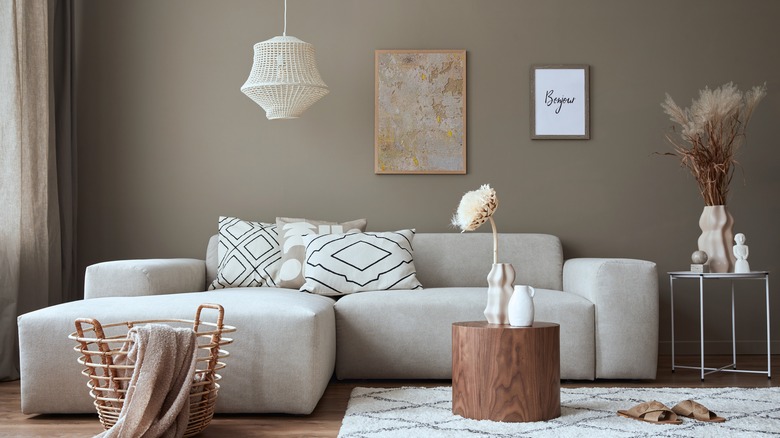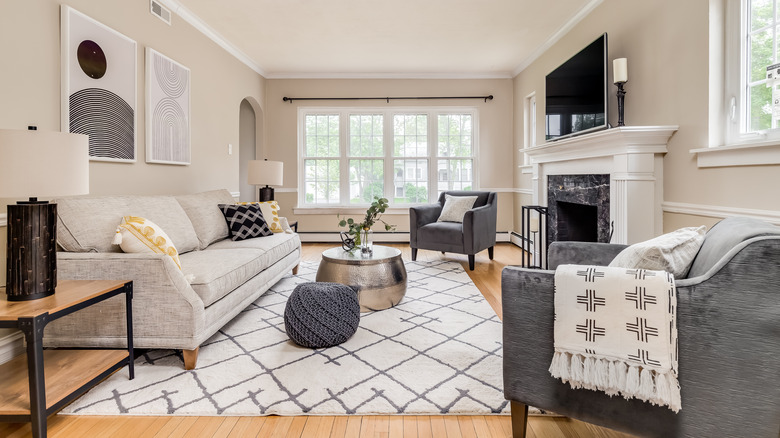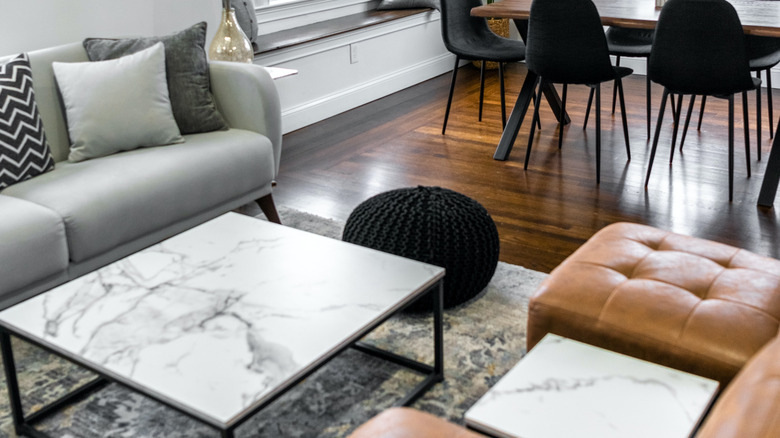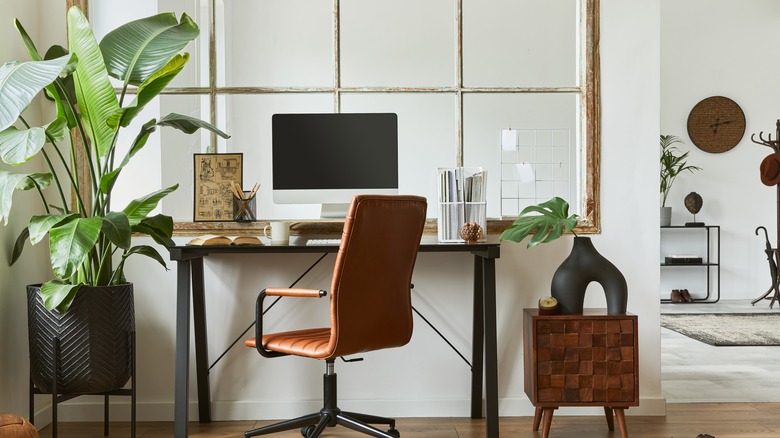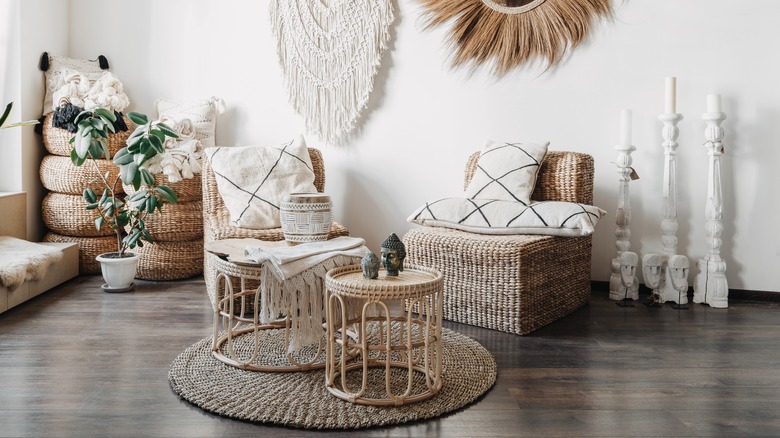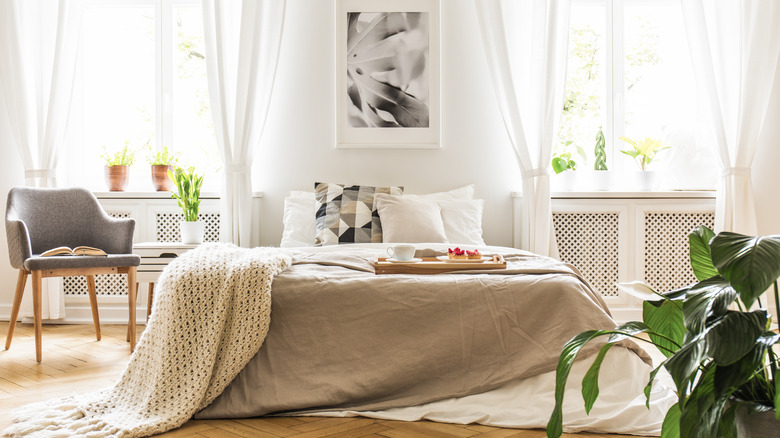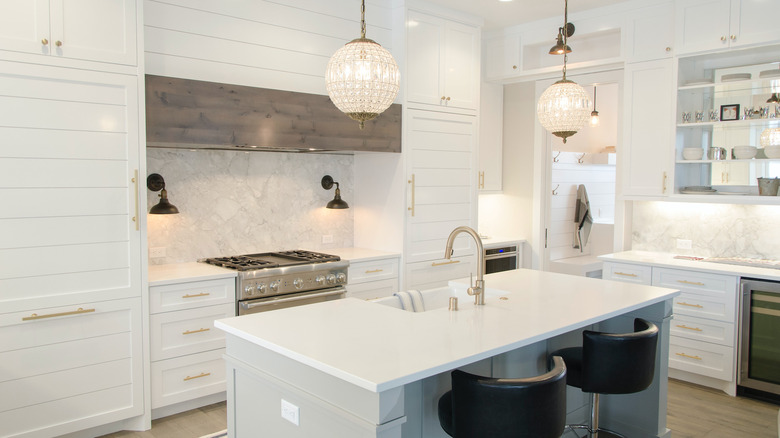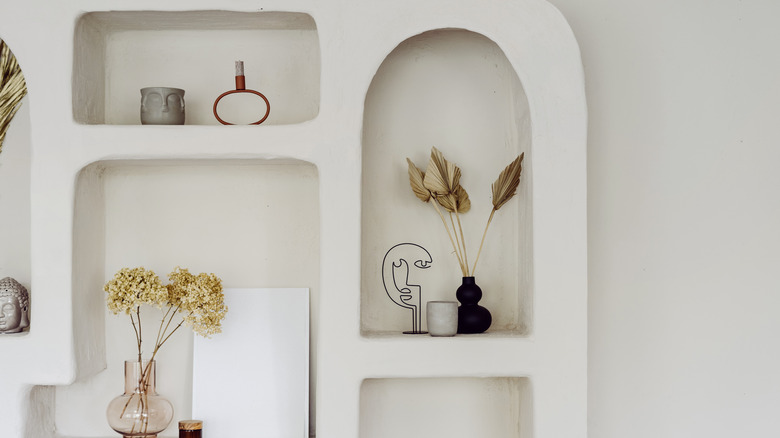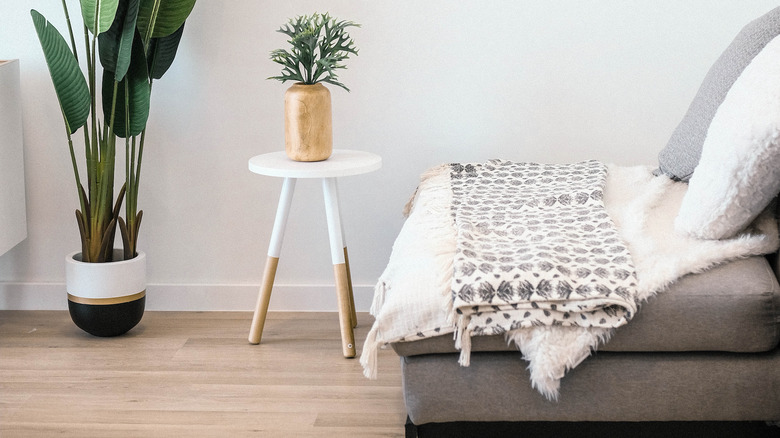The Best Ways To Use Neutrals In Home Decor
Neutral colors like gray, white, brown, black, and other muted shades can practically go with anything, making them a favorite in home design. According to Apartment Therapy, these subtle shades are just what you need to create the perfect calming living space. Neutral color tones like beige, white, brown, gray, and taupe are desirable when designing a home because they are highly versatile and can easily transition to fit different decor styles. Your style will evolve, which is why a neutral base is an attractive and enduring option.
Even though a neutral color scheme doesn't have flashy accents or busy patterns, it will still liven up your home. How exactly does one incorporate neutrals into their home decor? The first step is decorating with neutral shades that pair well with subtle layers and dull tones. Keep reading to find your inspiration and the best ways to incorporate neutrals into your home.
Design a monochromatic color palette
An ideal method for creating an all-neutral color scheme is to generate a collection of monochromatic colors in your home. The shades of color should vary slightly on your rugs, sofas, wall colors, and accent pieces. According to The Spruce, when blending shades of neutrals, you can create seamless pairings by ensuring they have the same warmth or coolness. To achieve a cohesive look in your home, determine the temperature of your color choices. Whether the shades are hot or cold will be a determining factor in the design continuity of the overall look. It's essential to maintain consistent saturation.
Some favorable warm neutrals are shades like oatmeal, linen, and sand (via Havenly). Use colors like gray, white, and taupe for a cool monochromatic palette. Understanding neutral tones will allow you to match them in your space without straying from the aesthetic. The same also applies to paint undertones. Choosing a monochromatic color scheme will make it easy to update and maintain a timeless design.
Toss in some pillows for texture
Neutral home decor can visually fall flat if there is not enough texture in the space. To prevent neutral shades from blending too much, incorporate contrasting elements to break up solid areas. No decorative accent does this better than a pillow. According to Ballard Designs, when you decorate with neutral pillows, textural details are essential additions. They will help balance the look. Stitched details, plaid patterns, floral designs, or weaved yarn will visually alter the monochromatic composition in your home. A combination of patterns, solid colors, and other intricate details will produce a designer-inspired look at home. Do not hesitate to combine different details on your pillow selections.
A decorator should capitalize on this decorative addition to add significant texture to neutral rooms. Pillows are versatile and the perfect plush accessory to create a cozy appearance. You can add pillows to furnishings such as a sofa, bed, bench, or accent chair. Swap them out to highlight an accent color or introduce textural features to elevate your neutral scheme.
Decorate with faux fur throws
Adding soft elements into your space will make it feel more relaxing and cozy. When decorating with neutrals, blankets should be the first thing on your mind. They are perfect for dressing any furniture item up or down. These decorative elements are similar to pillows since they are soft, versatile, and textured. Drape a throw off the side of a sofa or armchair, fold one across a seat, or pile throws in a corner basket.
Soft blankets and chenille throws are perfect for adding a cozy touch to your space. Opt for less colorful blankets for neutral-toned homes. Add layers of creams, grays, whites, and taupes that fit your neutral color combinations. Besides the traditionally neutral color choices, there is another way to incorporate a blanket with neutral hues and texture. If you want to spice things up, add a faux fur blanket. As interior designer Erin Gates said to Elle Decor, "Even if it's not real fur, all that texture and softness is a really rich texture to use in the home." Capitalize on opportunities to add a focal point to your neutral landscape.
Enhance the look with eucalyptus
Neutral homes can enjoy the natural beauty of plants with a toned-down version of flower power. Stick to the basics when choosing plants and flowers for your neutral home. To maintain neutrality throughout the design, aim for muted colors. If you adore fresh flowers, incorporate them into your home, but opt for neutral blooms like white roses, baby's breath, carnations, and hydrangeas to complement your decor.
If you are not arranging a flower bouquet, consider using simple green stems in place of the petals. Eucalyptus is an ideal stem for a neutral color palette as the soft green shade complements warm and cool colors. According to IKEA, you can decorate your home with eucalyptus using different hanging techniques. Fasten the stems around embroidery hoops, string a bundle together, create a garland, or set stems in a vase. This versatile neutral green does not lose its color when it dries, ensuring the beauty truly lasts forever.
Furnish the room with wood furniture
Large furniture pieces in natural wood finishes are perfect for your neutral home. The earthy tones of walnut, white oak, pine, and maple wood finishes are what you want to look for when shopping for furniture for your residence. These natural wood tones will charmingly complete your neutral color scheme. Where to add these wood-crafted pieces is a personal design choice and depends on the layout. Consider furniture pieces like coffee tables, credenzas, china cabinets, and stools. Measure the intended space to ensure a good fit without disrupting the natural flow.
According to The Spruce, rather than matching all the wood tones in the house, opt to contrast pieces. Blend a mixture of wood finishes throughout the entire space. For example, you can blend earthy tones with complementary wood finishes like cherry walnut or golden oak. For a cohesive grouping of furnishings in the same space, a decorator needs to find furniture pieces with similar hues, whether red, yellow, or brown. These matching undertones will give your home a high-end look.
Express how you feel with wall color
How do you want to feel when you are in your space? Create your ideal mood by painting your walls a specific color. As designer and color advisor Vincente Wolf said to Better Homes & Gardens, "First, find out what emotion you want your space to play into — airy, earthbound, dramatic — then proceed to choose your color from there." The best neutral paint colors will help set the mood in your space.
After deciding on that emotion, envision what color it would be and sample several shades in the actual room. This step is vital as colors do not look the same in all light sources. The lighting in the room is essential as the wall color will look different in artificial versus natural light settings. Sampling paint in the actual space will allow you to be sure the emotion you are trying to invoke is surfacing. Most paint companies offer sample sizes before a larger order is necessary. Considering any other elements that already exist in the room, some neutral wall colors to begin your selection could be in different variations of gray, brown, cream, and white shades (via Sherwin Williams).
Focus on the floors
Focus on the flooring in your home to significantly impact your neutral color palette. It's best to resist the urge to add dramatic pops of color with rugs, as it could take away from neutral looks. That does not mean you have to renovate existing tile, wood flooring, or carpet in your home. Instead, you can enhance your flooring style by adding an accent rug. This decorative feature elevates a room, ties together accent elements, and creates an anchored look in the space. Neutral rugs are the ideal foundation for other decorative elements in your home.
According to Architectural Digest, it's best to play it safe and decorate with a subdued rug. Choosing one with minimal patterns will complement existing color tones in the home. After all, a neutral rug can go with everything and create a sense of uniformity in the space. This technique lets you build on your design and easily alter the look as you see fit. Be sure to choose a rug toward the end of your design plan. This decorative puzzle piece should match your furniture.
Go wild for marble, wire, and stone accent pieces
Natural elements such as stone and wire are popular accent pieces for neutral homes because the smooth texture and versatility of the items create a contemporary look. Black wire baskets, gray or white cement bowls, or stone-crafted chain links are ideal decorative elements for a stack of books, shelf, or tabletop. You can leave these pieces empty or fill them with additional features like moss. Natural stone tile is also a great option for your bathroom or kitchen backsplash.
Marble is also an excellent, sturdy material perfect for a neutral home. You can source this material to match any neutral color palette since it features shades like white, gray, brown, and taupe. According to MyMove, marble is coming back in style, and it's now the perfect time to experiment with the material. You can decorate with small elements like candlesticks, lamps, trays, statues, and dishes, placing them on top of the tables and shelving. If you want to incorporate the material on a larger scale, consider marble-crafted pieces such as coffee tables, end tables, and countertops.
Add a mixture of metals
You can prevent your neutral oasis from appearing washed out by incorporating some shiny metallics into your home. To decorate with metallics, add elements with eye-catching texture to help you create a successful neutral design. Metals such as brass, copper, silver, and gold are ideal for completing a neutral color palette. These moments of simple grandeur make a neutral design feel elegant and composed. As with other neutral materials, it is imperative to pair cool and warm tones together to avoid overwhelming the space.
Invaluable shares that you can categorize metals into three types, including warm, cool, and neutral. These types of finishes add an elegant touch to any room lacking color. Metal accent elements can be sourced in any style or finish and make a neutral landscape shine. Add a piece of decorative wall art or opt for copper kitchenware. These dazzling bits of decor can be the perfect finishing touch for your neutral-colored home.
Woven textures add what color is missing
Furniture, rugs, and baskets made from natural handwoven jute, wool, wicker, or rattan add depth to your neutral interior design. Crate & Barrel offers a great variety of woven textures, including baskets, lampshades, and rugs. You can slide a basket under a coffee table, place them in corners, or at the foot of a bed to store blankets or cushions. Woven baskets are perfect for organizing any home.
The natural fibers in woven chairs and rugs complement most neutral colors. Brown and tan shades add a rainbow of neutral tones to your space and help introduce visual texture. The natural material brings a sense of warmth into the home, creating a cozier sensation that will make anyone want to be a homebody. The lack of color in a neutral home allows these pieces to add what is missing, making it a more inviting place for you and your houseguests.
Window treatments help maintain balance
A neutral home still needs some eye-catching elements. One decorative option is to create a bold visual in a neutral space with a window treatment. This decorative wall feature highlights the window and scenery outside while adding elements with different heights. The curtain rod and panel create an elevation change that draws the eye's attention.
When choosing a popular curtain style or pattern for your neutral home, consider what color the walls are or will be. If you have white or cream color walls, interior designer Keith Miller suggests to Martha Stewart, "opting for a semi-translucent sheer panel near the same color as your walls." The color similarity between the curtains and the wall will coordinate the look. If you prefer additional coverage and more privacy, opt for blackout curtains in lighter panel colors. Just note that the light filtering from the outside will alter drastically and change the appearance of some features in the interior.
Transform the space with light
You may be wondering how lights factor into a neutral home, and the answer is more than you think. Light fixtures dramatically change the visual appearance of a room as the shape, shade structure, finish, and style drastically alters a space. You can source these fixtures in neutral colors like gray, white, brown, black, and tan. They are also available in a range of metals and finishes to fit your style. Consider swapping out a dining room light or set of kitchen island pendants to spruce up your dwelling.
If overhead lighting is not something you can change, focus on switching up your accent lights. Table lamps and wall sconces are great options for adding a bit of ambient light. According to Home Interior Warehouse, soft lighting can make a cozy statement and set the mood in your room. Low lighting is ideal in bedroom areas and living rooms. Who doesn't like the lights turned low while watching a movie?
Incorporate architectural details
Sometimes the best way to decorate a neutral home is by altering the structural components. If you are trying to keep the neutral design in your home from feeling one-dimensional, amplify the texture and increase the architectural features. This alteration in form is just what a neutral decor needs as the structures create a shift in the layout. Imagine arches in hallways and the entrance area or steps and glass doors in rooms and offices.
To incorporate this look into your neutral home, consider creating an accent wall made of stone or shiplap and adding crown molding to the walls at the top and bottom. You can install shiplap on a wall yourself if you want to do a DIY project. According to HGTV, you can also consider adding decorative columns to the home. This architectural detail elevates any living space, and you can install it to create a classic look. This feature will also help segment an open layout and create a natural flow in your home.
Keep the patterns simple
While you may worry you have too many patterns in your neutral home, it's not necessarily the amount that sways the look. According to MasterClass, you should vary the size, quantity, and style when decorating with patterns. Patterns are decorative elements, and you should use them to add some chic style to your home.
Using patterns is not unheard of in neutral decor. They are actually encouraged, as they provide an opportunity to add movement into a static space. Patterns can be busy and overwhelming, so be wary of the ones that disrupt the mood in your room. Pick no more than three patterns to blend in a room for a subtle approach. The best way to incorporate neutrals into your home decor is by balancing the tones in the materials, colors, and textiles used to decorate your home. Using too many different colors can make a room feel busy and chaotic. Be sure to bring in some chic solids to complement the pattern designs.
